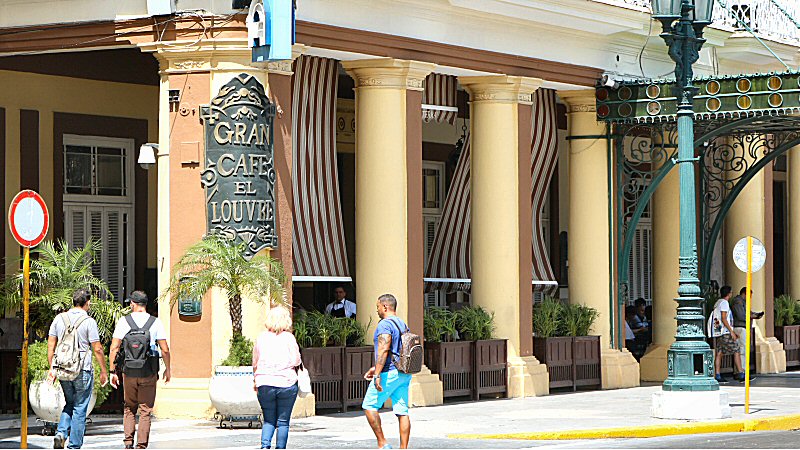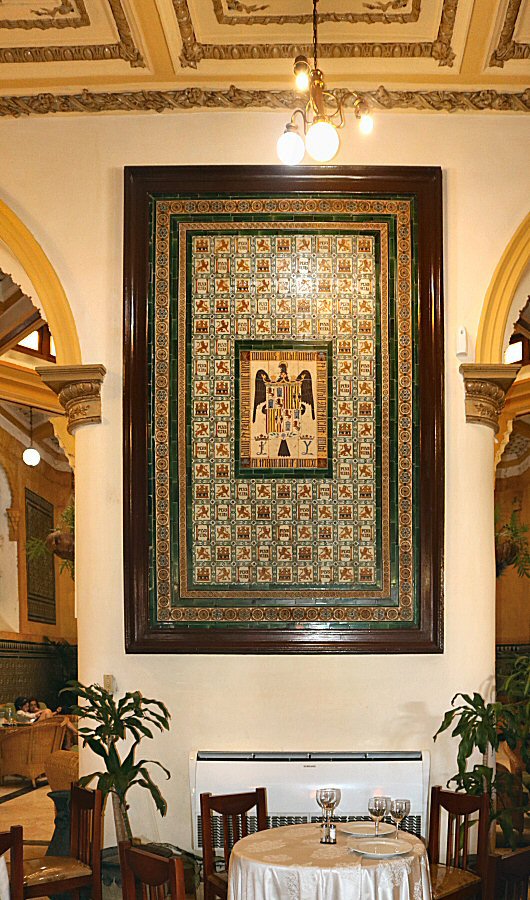

In 2016 the Starwood Hotels & Resorts
Worldwide (currently incorporated in the Marriott International
hotel chain) received special authorization from the US Treasury
to operate the Hotel Inglaterra. Thus, the Hotel Inglaterra
would be the first hotel in Cuba to be managed by an American
company. However, the Four Points by Sheraton in Havana
(previously the Hotel Quinta Avenida) got ahead of the Hotel
Inglaterra, so that currently the Hotel Inglaterra is the second
in this category.
Although the hotel underwent several
renovations and restorations, principally nothing changed at the
image of the neoclassical hotel that was formed already in the
second half of the 20th century. The interior shows the
influence of the Mudejar architecture with stained glass windows
and heraldic symbols. The ground floor of the Hotel Inglaterra
is wastefully adorned with chandeliers, dark glasses, ornaments
of figured iron and marble floors. The refulgent, golden mosaics
from Alicante and the embossed grills from Seville creates a
different atmosphere that you can’t find in modern hotels.
In the center of the Coffee Bar La
Sevillana, there is the bronze statue of Carmen Bizet, the
famous Spanish dancer, made by the Marquess of Perrinat that was
a fan of art of sculpture. It is said that she was close friend
with Eugenia de Montijo, the last Empress of the France and the
wife of the Emperor Napoleon III, and she used the Grenadian
Empress as the model at this sculpture.
In the snack
bar Seville, you will see the golden statue of a flamenco
dancer. It is said that it belongs to the Spanish actress and
dancer Agustina del Carmen Otero Iglesias, better known
as La Bella Otero.
The tables in Grand Cafe El Louvre are
adorned with the paintings of some of the best Cuban artists,
like Flora Fong, Manuel Mendive, Zaida del Rio, Sigfredo Ariel,
Nelson Domínguez.
The corridors of the hotel are adorned
with several plates and shields on the walls. They are hung to
pay tribute to some personalities, but some of them are also
used simply as decorative objects. The shield on the wall of the
bar represents the unification of all Spanish territory after
the victory over the Moors and their expulsion from the
peninsula. The shield on the wall in the restaurant has the same
theme: it represents the unification of Spain though the
marriage of Isabel la Católica, the Queen of Castile and Leon,
and Ferdinand II (Fernando el Católico), the King of
Aragon, Sicily, Napels, Valencia and Sardinia, after the defeat
of the Moors in Granada in 1492. On the columns of the lobby,
you can see also other shields that correspond to the noble
titles of Spain, such as the shield of the Marquises of Casa
Calvo, a Spanish nobility title created by the Spanish King
Carlos III in 1788. It is well known by charitable Martín Calvo
de la Puerta y Arrieta that built the Casa de la Obra Pía.
 There is another shield on the fourth
floor of the façade of the hotel. It belongs to María del
Carmen Lucrecia Terry y Dorticós, the widow of Guillermo de
Perinat y Ochoa de Sevilla. She received the knighthood, the
Marquesado de Perinat, by virtue of the merits of her charitable
husband in 1893.
There is another shield on the fourth
floor of the façade of the hotel. It belongs to María del
Carmen Lucrecia Terry y Dorticós, the widow of Guillermo de
Perinat y Ochoa de Sevilla. She received the knighthood, the
Marquesado de Perinat, by virtue of the merits of her charitable
husband in 1893.
On the columns in front of the hotel, there are two shields more. One of them is hung to pay tribute to the 40 young people that became regulars at the Acera del Louvre and fell in the fight during the War of Independence. Their names are listed on the shield. The second shield is hung in honor to the memory of Nicolás Estévanez Murphy, a Spanish officer with the rank of captain that broke his sword at the Acera del Louvre to protest the iniquitous execution of eight medical students in 1871. He was claiming the Spanish authorities by these words: “above homeland are unity and justice”. He was expelled from the military, but he never apologized or renounced his action. He returned to Spain and became a writer, poet and a politician (minister in the cabinet of the First Spanish Republic). The shield was hung on the the initiative of the city historian Emilio Roig de Leuchsenring in 1937.
At the beginning of the street right next to the Gran Café El Louvre, there is a bronze statue depicting a man and a woman kissing enthusiastically. The sculpture named "Kiss" is the work of the Chinese sculptor Xu Hongfei. It is part of a series of sculptures consisting of energetic, chubby female bodies engaged in daily life activities, which the artist has exhibited in various parts of the world.